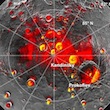 Welcome back to Science Saturday! This week: a new medical tricorder hits the market, and is going for a mere $150! Witness a new form of weapons technology that can power-down a city block, but leave humans and buildings undamaged. Read about the latest discoveries in planetary science — water ice on Mercury and complex organic compounds on Mars! Plus, see how scientists can ‘print’ new drugs, molecule by molecule. All this and more, plus our gadget of the week: The CommBadge bluetooth communicator.
Welcome back to Science Saturday! This week: a new medical tricorder hits the market, and is going for a mere $150! Witness a new form of weapons technology that can power-down a city block, but leave humans and buildings undamaged. Read about the latest discoveries in planetary science — water ice on Mercury and complex organic compounds on Mars! Plus, see how scientists can ‘print’ new drugs, molecule by molecule. All this and more, plus our gadget of the week: The CommBadge bluetooth communicator.
A Medical Tricorder for only $150? It’s Coming in 2013
We’ve seen our fair share of “real” Trek tech, but the Scandu SCOUT stands out from the rest. Why? Because it’s actually being manufactured for sale to the general public starting in 2013. It’s beyond the prototype stage already — that is, there exists working models of the thing. The SCOUT is a small handheld device that can read your vitals on contact — pulse transit time, heart rate, electrical heart activity, temperature, heart rate variability and blood oxygenation — by holding it to your temple. The data is then all read out on your smartphone. The company has two other products, ScanaFlu and ScanaFlo, that are equally impressive, but they are still in the prototype stage. This could change the way we self-diagnose ourselves and our families, but I’d say it’s still a good idea to get a second opinion from a real human doctor at this point.
Gizmodo got a good look at the Scandu SCOUT. Check out their very detailed review.
Lights Out – This Weapon Can Fry Your Harddrive, Leaves People and Buildings In Tact
I’m usually not so enthused about new weapons technology, but this one has the potential to actually save lives. The CHAMP (Counter-electronics High-powered Microwave Advanced Missile Project) is a new “missile” developed by Boeing and the U.S. Air Force that can fry electronic devices using selective high-frequency radio wave strikes, leaving people and buildings unharmed. This is a tech we’ve seen before in science fiction, but it’s a first in the real world and has the potential to change the nature of the battlefield as we know it.
More at Boeing.
Newly Discovered Complex Organics on Mars and Water Ice on Mercury
Two big planetary discoveries were announced and discussed at this year’s American Geophysical Union conference held annually in San Francisco’s Moscone Center. The Mars Curiosity team announced to a group of eagerly awaiting scientists that the Curiosity Mars Science Laboratory rover has detected chlorinated hydrocarbons on the surface of Mars. This is a substantial finding, since the presence of these chemicals points to complex organics and water on the red planet. Searching for complex organic compounds, the building blocks of life, has been one of Curiosity’s main goals. It’s not been ruled out that the carbon may be terrestrial in origin (that is, the scientists want to double check that Curiosity didn’t bring some carbon with her from Earth). But, if the stuff is in fact Martian, this is good news for people hoping to find evidence of life there.
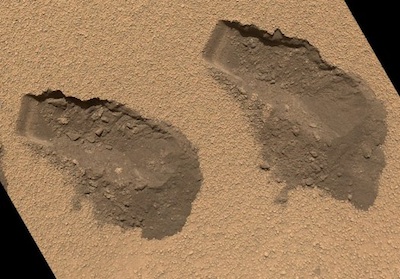
Scoops of Martian soil containing complex compounds. Image credit: NASA/JPL-Caltech
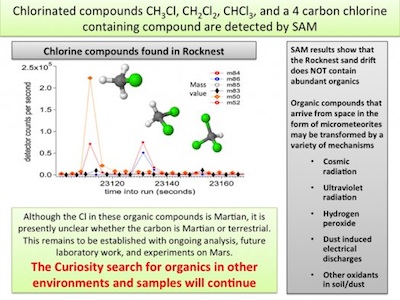
Slide from the Curiosity team’s presentation showing the compounds found in Martian soil samples. Credit: NASA/JPL-Caltech
In another exciting discovery, scientists working with data from the MESSENGER spacecraft currently in orbit around Mercury have proven what has been postulated for decades — that there is water ice on the planet Mercury. It seems odd that a planet so close to the sun would have ice, but, unlike Earth with a tilt of 23.5°, Mercury is almost tiltless, meaning that there are regions where the sun’s harsh rays never shine. Like our own moon, it appears that water ice survives in polar craters that are in permanent shadow. And, Mercury’s got water it in spades. It’s thought that billions of tons of H2O is frozen on the surface. The first hints that water may exist on Mercury came from radio data over two decades ago, which MESSENGER has now shown to be accurate.
More at The BBC. And, read the paper in press in the Journal of Geophysical Research.
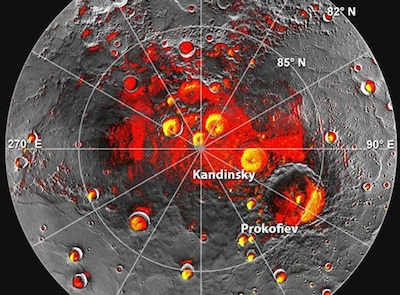
The red are areas of Mercury’s north pole that are in shadow in all images acquired by MESSENGER. The polar deposits imaged by Earth-based radar are in yellow.
Image Credit: NASA/Johns Hopkins University Applied Physics Laboratory/Carnegie Institution of Washington/National Astronomy and Ionosphere Center, Arecibo Observatory
A New Way to Print Drugs, Molecule by Molecule
Researchers have developed a new way to create medications through a simple “drag and drop” computer interface that automates the drug development progress, allowing the compounds to be printed one molecule at a time, called the Parabon Essemblix. The new technology could shorten the time required to fabricate and test new medicines. “We can now ‘print,’ molecule by molecule, exactly the compound that we want,” says Steven Armentrout, co-developer of the technology from Parabon NanoLabs. “What differentiates our nanotechnology from others is our ability to rapidly, and precisely, specify the placement of every atom in a compound that we design.” To develop new drugs, scientists can use computer aided design (CAD) software to choose molecular pieces with specific, functional components. The software then optimizes the design using a cloud supercomputing platform that uses proprietary algorithms to search for specific sets of DNA sequences that can self-assemble those components. It always seems like magic when a starship’s doctor can whip up a batch of some synthesized compound, saving the bridge crew just in the nick of time. But, this molecular printing technology and self-assembling medical compounds makes that scenario seem a bit less far fetched.
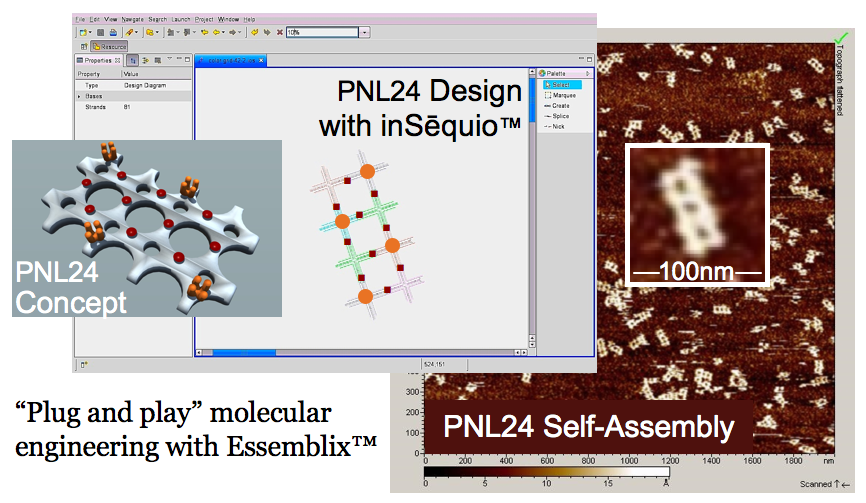
The Essemblix process
Video of the Week: Shatner Talks Up Medical Spin-off Technology from NASA
Our very own Captain Kirk acts as spokes person promoting medical spin-off technology that’s come from NASA. Many people don’t realize why we invest in space, but, as Shatner says, there’s more space in your life than you think!
Pic of the Week: NASA’s Black Marble — Earth at Night
NASA recently released unprecedented new images of the Earth at night called NASA’s Black Marble. The image is a global composite image, constructed using cloud-free night images from a new NASA and National Oceanic and Atmospheric Administration (NOAA) satellite, shows the glow of natural and human-built phenomena across Earth in greater detail than ever before. Click on the image below for the glorious full resolution version. Can you see your house?

Click on the image for a bigger version!
Gadget of the Week: CommBadge Wearable Bluetooth Communicator
The CommBadge is really aptly named, since it is the modern day equivalent of a Starfleet-issued, well, Comm Badge! Just like a Trek Comm Badge, this CommBadge attaches to your clothing allowing you to wirelessly control your smartphone to make and receive calls and even search the web or dictate an email (using your phone’s Siri or Google Now service). Really, it’s a bluetooth headset that you wear on your shirt instead of in your ear, but if they made one in the shape of a Trek comm badge, I would throw my money at that in a second. It’d be some pretty sleek convention wear. Check out CommBadge’s Indigogo campaign, where you can pledge $75 to get your own (it’s slated to retail at $100 USD).
Science Bytes
Not enough science for you? Here’s a warp-speed look at some more science tid-bits that are worth a peek.
- As Voyager 1 exits solar system, plan to extend life remains undecided
- Students learn better with Star Trek style touch screen desks
- SpaceX gets its first military contract
Follow me on Twitter: @kaylai.

Excellent articles. Much needed.
Good science fiction inspires science, inspires people to become scientists and fosters a support of education within society. Science fiction making everything a war, explosions and tracking down psycho mass-murders just wastes time and dumbs down everything. A documentary titled “Monsters from the ID” explains this intelligently.
Thanks you for these inspiring Science Saturday postings.
Weapons = rise of the machines
I hope QMX reads this article!
thanks kayla =)
what ever happened with that bluetooth TOS communicator…?
Douglas: well said =)
Thank you, Kayla, for your informative article. Your science contributions are what make coming to this site educational as well as fun.
I think we should all spread the word about how useful your articles are to Trek fan and non-fan alike!
P.S.: I also covered the CommBadge venture in my own blog. :-)
http://hatricksblog.blogspot.ca/2012/12/new-project-to-make-comm-badges-reality.html#!/2012/12/new-project-to-make-comm-badges-reality.html
Thank you Kayla and TrekMovie for bringing back Science Saturday; always an enjoyable part of my week.
It’s good to see the site coming back to life.
That’s just what we need. EMP weapons that can make that Failed TV show Revolution, or the show that made Jessica Alba and Michael Weatherly famous, Dark Angel, real. (the latter minus the genetic engineering). Imagine if an enemy power or some rogue domestic terrorists detonated an EMP warhead above a nuclear plant :S There goes the saving lives part.
Still, I want those Tricorder add-ons! Even aside from it being similar to TrekTech, that CommBadge Bluetoooth device is very practical.
Thank you, Kayla. I really enjoy these updates.
Can’t help but notice that my home, Atlanta, seems to be the world leader in light pollution.
The Mars information is so dang tantilizing. We really need to find a freakin’ Martian and be done with it. OF COURSE there’s life in the universe. DUH to 1,000,000,000,000,000th power.
Does Shat have dentures? Looks like it.
Love that my next phone will likely have a tricorder, so I can obsess about my weight and blood pressure with the touch of a button.
Thanks Kayla
That “Black Marble” map is indeed striking and quite beautiful. One thing that I found interesting is the difference between North and South Korea. South Korea is lit up all the way to the 38th parallel (indeed the dividing line is lit up as well). By comparrison, all of North Korea is in darkness save for a few isolated spots.
Some of these photos, like the “Black marble” are great, but don’t seem toi display easily.
For example. when I click that link, I can scroll up and downthe photo, but NOT left to right. Anyone have a pointer to an article that might tell me what I’m doing wrong?
@9. CmdrR – “Can’t help but notice that my home, Atlanta, seems to be the world leader in light pollution. ”
Yeah – I’d LIKE to see that (and check out MY home, Smyrna [grin] Just can’t scroll over there!
Right click on the photo and choose “open in a new window”. You should be able to view the photo without the display problem on this site.
Wil Wheaton and Dr. Neil DeGrasse Tyson talk science Trek!
“I was an enormous Star Trek fan before I was cast in The Next Generation,” banters Wil.
“As Wellesley Crusher,” Tyson responds.
Yes, Dr. Tyson. If you say so!
Video available at http://tinyurl.com/wheatontyson
Funny stuff!
Great article as usual. Thanks very much Kayla!
@13. Dave in RI – Right click on the photo and choose “open in a new window”.
Well, durn! I shoulda hadda oughta uh thunk uh that myself.
Thanks! I love it when it’s that simple.
(“Which way did they go, George? Which way did they go..?)”
Funny, I built my own bluetooth comm badge 3 years ago. I use it everyday and it still works fine. Some people laugh at me when they see me wearing it until I use it, then they think its cool… Go Figure :p
Thanks Kayla. Always great to read these.
Excellent work, Kayla. Fascinating stuff. Water on Mercury. That molecule printer reminded me of the scene in Star Trek IV where Scotty prints up transparent aluminum.